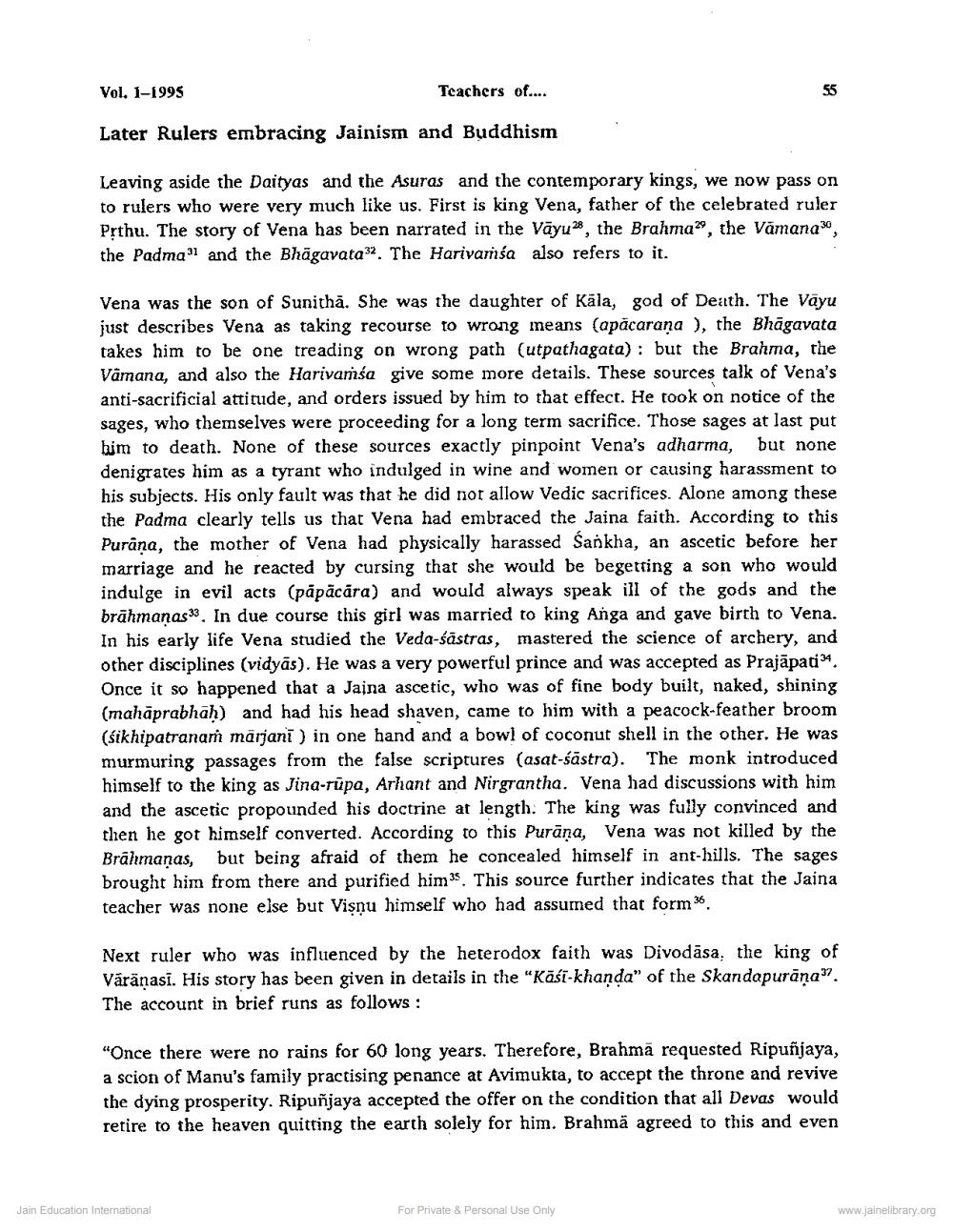Book Title: Teachers of Heterodox Sects Buddhism and Jainism in eyes of Puranas Author(s): N P Joshi Publisher: Z_Nirgrantha_1_022701.pdf and Nirgrantha_2_022702.pdf and Nirgrantha_3_022703.pdf View full book textPage 6
________________ Vol. 1-1995 Teachers of.... Later Rulers embracing Jainism and Buddhism Leaving aside the Daityas and the Asuras and the contemporary kings, we now pass on to rulers who were very much like us. First is king Vena, father of the celebrated ruler Prthu. The story of Vena has been narrated in the Vāyu, the Brahma, the Vamana, the Padma" and the Bhagavata. The Harivamsa also refers to it. Vena was the son of Sunithă. She was the daughter of Käla, god of Death. The Väyu just describes Vena as taking recourse to wrong means (apăcarana ), the Bhagavata takes him to be one treading on wrong path (utpathagata): but the Brahma, the Vamana, and also the Harivamśa give some more details. These sources talk of Vena's anti-sacrificial attitude, and orders issued by him to that effect. He took on notice of the sages, who themselves were proceeding for a long term sacrifice. Those sages at last put him to death. None of these sources exactly pinpoint Vena's adharma, but none denigrates him as a tyrant who indulged in wine and women or causing harassment to his subjects. His only fault was that he did not allow Vedic sacrifices. Alone among these the Padma clearly tells us that Vena had embraced the Jaina faith. According to this Purana, the mother of Vena had physically harassed Sankha, an ascetic before her marriage and he reacted by cursing that she would be begetting a son who would indulge in evil acts (päpäcára) and would always speak ill of the gods and the brāhmanas 33. In due course this girl was married to king Anga and gave birth to Vena. In his early life Vena studied the Veda-śāstras, mastered the science of archery, and other disciplines (vidyās). He was a very powerful prince and was accepted as Prajāpati Once it so happened that a Jaina ascetic, who was of fine body built, naked, shining (mahaprabhah) and had his head shaven, came to him with a peacock-feather broom (śikhipatranam marjani ) in one hand and a bowl of coconut shell in the other. He was murmuring passages from the false scriptures (asat-śāstra). The monk introduced himself to the king as Jina-rupa, Arhant and Nirgrantha. Vena had discussions with him and the ascetic propounded his doctrine at length. The king was fully convinced and then he got himself converted. According to this Purāņa, Vena was not killed by the Brahmanas, but being afraid of them he concealed himself in ant-hills. The sages brought him from there and purified him. This source further indicates that the Jaina teacher was none else but Visnu himself who had assumed that form 36. Next ruler who was influenced by the heterodox faith was Divodása, the king of Vārāṇasī. His story has been given in details in the “Kāśi-khanda" of the Skandapurāņa. The account in brief runs as follows: "Once there were no rains for 60 long years. Therefore, Brahmä requested Ripuñjaya, a scion of Manu's family practising penance at Avimukta, to accept the throne and revive the dying prosperity. Ripuñjaya accepted the offer on the condition that all Devas would retire to the heaven quitting the earth solely for him. Brahmä agreed to this and even Jain Education International For Private & Personal Use Only www.jainelibrary.orgPage Navigation
1 ... 4 5 6 7 8 9 10 11 12 13 14 15 16 17 18 19
